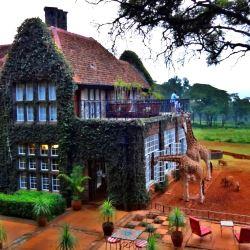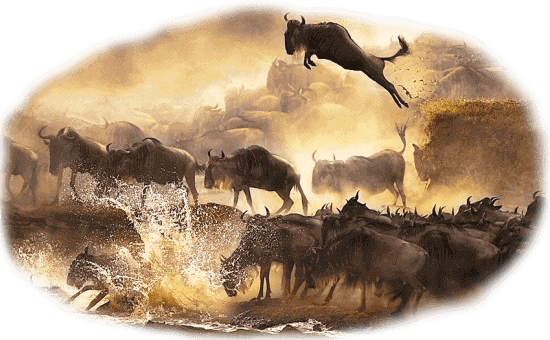 Kenya is a land where history and culture intertwine with natural splendor, offering German tourists more than just a safari adventure. With a past shaped by ancient civilizations, colonial rule, and rich indigenous traditions, Kenya boasts a variety of historical landmarks that bring its dynamic heritage to life. These sites are not only fascinating to visit but also serve as windows into the country's diverse identity and historical evolution. German travelers, known for their appreciation of culture and history, will find Kenya's historical offerings deeply enriching. Fort Jesus in Mombasa stands as a grand symbol of the Portuguese colonial era, with its imposing structure and museum that narrate centuries of conflict and commerce. Equally compelling are the Gedi Ruins nestled in coastal forests a mysterious and abandoned Swahili town from the 13th century, ideal for those curious about Africa's lesser-known urban pasts. Further up the coast lies Lamu Old Town, a UNESCO World Heritage Site that embodies Swahili culture and Islamic influence through its preserved architecture, car-free streets, and vibrant maritime traditions. German tourists seeking a tranquil yet historically immersive setting will be enchanted by Lamu's charm and heritage. Inland, Nairobi serves as a hub for colonial and post-independence landmarks. The Karen Blixen Museum gives a personal view into colonial settler life and literature, while Uhuru Gardens commemorates Kenya's journey to sovereignty with monuments and open green spaces. For those intrigued by engineering feats and transportation history, the Nairobi Railway Museum offers a nostalgic look at the infamous "Lunatic Express." For cultural depth, Bomas of Kenya and the National Museums provide interactive and well-curated explorations of Kenya’s 40-plus ethnic communities. Traditional homesteads, music, dances, and exhibitions help visitors appreciate the living traditions that still shape the nation. Those with scientific interests can venture to Lake Turkana, where the Turkana Boy Monument marks one of the most significant human fossil discoveries. These destinations form the best historical sites to visit in Kenya for German tourists. They offer not just sightseeing opportunities, but immersive narratives that resonate with intellectually curious travelers. From prehistoric artifacts to colonial memoirs and living cultural traditions, Kenya provides a journey through time that is both unforgettable and enlightening. For German visitors planning their African getaway, Kenya's historical sites stand as must-see experiences that promise depth, diversity, and discovery. These heritage-rich destinations offer a compelling blend of storytelling, architectural marvels, and preserved cultural practices that go beyond surface-level tourism. Whether it’s walking through the atmospheric streets of Lamu Old Town or examining prehistoric remains near Lake Turkana, each location delivers a powerful sense of place and history. What sets Kenya apart is its ability to showcase a multi-layered historical narrative from ancient Swahili trade routes and medieval ruins to the colonial era and the modern nation’s independence struggle. For many German tourists, who often prioritize meaningful, educational travel experiences, this makes Kenya not just a vacation spot but a profound journey through time. Local guides and museums increasingly provide tours and resources in German, making the experience accessible and engaging. The country's historical sites are integrated into scenic and often eco-friendly surroundings, providing a holistic experience that combines history, culture, and nature. Exploring Fort Jesus after a coastal morning swim or ending a visit to the Railway Museum with a walk in Nairobi's urban green spaces makes the historical exploration feel seamless and enjoyable. For those seeking a destination that offers intellectual enrichment, cultural authenticity, and adventure all in one, Kenya's historical sites deliver. These landmarks do more than narrate the past they invite German travelers to become part of an ongoing dialogue between history and modern identity.
Kenya is a land where history and culture intertwine with natural splendor, offering German tourists more than just a safari adventure. With a past shaped by ancient civilizations, colonial rule, and rich indigenous traditions, Kenya boasts a variety of historical landmarks that bring its dynamic heritage to life. These sites are not only fascinating to visit but also serve as windows into the country's diverse identity and historical evolution. German travelers, known for their appreciation of culture and history, will find Kenya's historical offerings deeply enriching. Fort Jesus in Mombasa stands as a grand symbol of the Portuguese colonial era, with its imposing structure and museum that narrate centuries of conflict and commerce. Equally compelling are the Gedi Ruins nestled in coastal forests a mysterious and abandoned Swahili town from the 13th century, ideal for those curious about Africa's lesser-known urban pasts. Further up the coast lies Lamu Old Town, a UNESCO World Heritage Site that embodies Swahili culture and Islamic influence through its preserved architecture, car-free streets, and vibrant maritime traditions. German tourists seeking a tranquil yet historically immersive setting will be enchanted by Lamu's charm and heritage. Inland, Nairobi serves as a hub for colonial and post-independence landmarks. The Karen Blixen Museum gives a personal view into colonial settler life and literature, while Uhuru Gardens commemorates Kenya's journey to sovereignty with monuments and open green spaces. For those intrigued by engineering feats and transportation history, the Nairobi Railway Museum offers a nostalgic look at the infamous "Lunatic Express." For cultural depth, Bomas of Kenya and the National Museums provide interactive and well-curated explorations of Kenya’s 40-plus ethnic communities. Traditional homesteads, music, dances, and exhibitions help visitors appreciate the living traditions that still shape the nation. Those with scientific interests can venture to Lake Turkana, where the Turkana Boy Monument marks one of the most significant human fossil discoveries. These destinations form the best historical sites to visit in Kenya for German tourists. They offer not just sightseeing opportunities, but immersive narratives that resonate with intellectually curious travelers. From prehistoric artifacts to colonial memoirs and living cultural traditions, Kenya provides a journey through time that is both unforgettable and enlightening. For German visitors planning their African getaway, Kenya's historical sites stand as must-see experiences that promise depth, diversity, and discovery. These heritage-rich destinations offer a compelling blend of storytelling, architectural marvels, and preserved cultural practices that go beyond surface-level tourism. Whether it’s walking through the atmospheric streets of Lamu Old Town or examining prehistoric remains near Lake Turkana, each location delivers a powerful sense of place and history. What sets Kenya apart is its ability to showcase a multi-layered historical narrative from ancient Swahili trade routes and medieval ruins to the colonial era and the modern nation’s independence struggle. For many German tourists, who often prioritize meaningful, educational travel experiences, this makes Kenya not just a vacation spot but a profound journey through time. Local guides and museums increasingly provide tours and resources in German, making the experience accessible and engaging. The country's historical sites are integrated into scenic and often eco-friendly surroundings, providing a holistic experience that combines history, culture, and nature. Exploring Fort Jesus after a coastal morning swim or ending a visit to the Railway Museum with a walk in Nairobi's urban green spaces makes the historical exploration feel seamless and enjoyable. For those seeking a destination that offers intellectual enrichment, cultural authenticity, and adventure all in one, Kenya's historical sites deliver. These landmarks do more than narrate the past they invite German travelers to become part of an ongoing dialogue between history and modern identity.
Key Historical Sites for German Tourists
| Historical Site | Location | Key Highlights | Ideal For |
|---|---|---|---|
| Fort Jesus | Mombasa | UNESCO site, Portuguese architecture, museum | History buffs, architecture fans |
| Gedi Ruins | Malindi | Ancient Swahili town, forest setting | Archaeology lovers |
| Lamu Old Town | Lamu Island | Swahili culture, traditional lifestyle | Cultural explorers |
| Karen Blixen Museum | Nairobi | Colonial life, literary history | Literature & film fans |
| Uhuru Gardens | Nairobi | Independence monument, peaceful park | History and politics enthusiasts |
| Railway Museum | Nairobi | Colonial rail history, vintage trains | Engineering & history fans |
| Bomas of Kenya | Nairobi | Cultural dances, tribal homesteads | Families, culture enthusiasts |
| National Museums | Various Cities | Comprehensive exhibits, regional diversity | General interest tourists |
| Turkana Boy Monument | Lake Turkana | Human evolution, archaeology | Science and archaeology tourists |
Top Historical Landmarks in Kenya That Attract German Tourists
Kenya is a destination steeped in history, making it an ideal location for German tourists who cherish cultural depth and historical context. The country's array of landmarks presents stories from different epochs, offering a diverse and immersive travel experience. Whether it's ancient Swahili cities, colonial-era architecture, or indigenous heritage centers, Kenya delivers a compelling historical journey. One standout destination is Fort Jesus in Mombasa, built by the Portuguese in the late 16th century. Its architectural resilience and strategic location illustrate centuries of conflict and commerce at the Kenyan coast. This UNESCO World Heritage Site now serves as a museum, featuring exhibitions that highlight maritime history and the cultural exchanges that occurred through Mombasa's port. For German tourists interested in colonial influence and European-African interactions, Fort Jesus is a must-visit. Equally fascinating are the Gedi Ruins near Malindi. These 13th-century remains of a once-thriving Swahili town are nestled within the Arabuko Sokoke Forest. Archaeological evidence at the site suggests advanced planning, international trade, and complex social structures. The mysterious abandonment of the site adds a sense of intrigue that will captivate historically curious visitors. Lamu Old Town offers yet another glimpse into Swahili heritage. Its narrow alleys, carved wooden doors, and coral stone buildings speak to centuries of uninterrupted culture. Designated as a UNESCO World Heritage Site, Lamu remains a living town with a rich Islamic and Swahili identity, perfect for travelers seeking authenticity. These locations represent top must-see heritage attractions in Kenya for Germans. They provide not only scenic and photographic beauty but also deep-rooted stories of human civilization and interaction. Fort Jesus reveals the power struggles and maritime significance of Mombasa, while the Gedi Ruins evoke a sense of wonder about the advanced societies that once thrived on the East African coast. Each site is layered with stories that reflect Kenya's multifaceted identity. For German visitors with a passion for history, architecture, and cultural exploration, Kenya's historical sites promise an experience as intellectually stimulating as it is unforgettable. The preservation efforts and storytelling embedded in these landmarks provide more than just visual appeal; they offer a narrative that helps travelers connect with Kenya's past in a meaningful way. Visitors can walk through stone-paved streets that echo with centuries of trade, faith, and community life, making history come alive through every doorway and inscription. Moreover, the accessibility of many of these sites enhanced by guided tours and informative signage, often available in German ensures that tourists can deeply engage with what they are seeing. This thoughtful inclusion adds to the educational value of the journey, aligning perfectly with the preferences of culturally conscious travelers from Germany. As a result, these attractions serve not only as places of learning and reflection but also as inspiration for future exploration into Kenya's rich and diverse heritage.
Best Ancient Ruins and Heritage Sites in Kenya for German Visitors
Kenya is home to numerous ancient ruins and cultural heritage sites that tell stories of thriving Swahili civilizations, Portuguese explorers, and indigenous communities. For German tourists who are often well-traveled and historically curious, these destinations offer not just photo opportunities but deep cultural immersion. Many of these landmarks are integral parts of Kenya cultural heritage tours for German travelers, designed to provide a comprehensive and engaging understanding of the nation's diverse past.
- Fort Jesus, Mombasa: Built in 1593 by the Portuguese, Fort Jesus is one of Kenya’s most iconic historical landmarks. Located in the coastal city of Mombasa, the fort was constructed to protect the port of Mombasa and has seen several occupations, including Arab, Portuguese, and British forces. Today, Fort Jesus is a UNESCO World Heritage Site and serves as a museum that provides invaluable insights into the region’s colonial history. German tourists will find the site particularly interesting due to its European architectural influences, rich maritime history, and well-preserved artifacts. Guided tours are available in multiple languages, including German, which enhances the learning experience.
- Gedi Ruins: Hidden within the Arabuko Sokoke Forest, the Gedi Ruins offer a surreal glimpse into a once-thriving Swahili town that dates back to the 13th century. The site features remnants of stone houses, mosques, and a palace complex, all surrounded by ancient baobab trees. Gedi is ideal for German tourists who are intrigued by archaeology and ancient civilizations. The mysterious abandonment of the town still puzzles historians, adding a layer of enigma that makes a visit even more engaging.
- Lamu Old Town: Lamu is the oldest and best-preserved Swahili settlement in East Africa, showcasing traditional architecture, narrow winding streets, and a strong Islamic cultural influence. As another UNESCO World Heritage Site, Lamu Old Town is a testament to the blending of African, Arab, and Indian cultures. German travelers who appreciate historical preservation and cultural continuity will find Lamu enchanting. With its car-free streets and dhow sailing experiences, Lamu offers a slow-paced yet immersive cultural journey.
Colonial and Independence-Era Sites in Kenya Worth Exploring
Kenya’s colonial and independence-era landmarks present a compelling journey through the country's path to self-governance and national identity. These sites are rich with stories of resilience, cultural transitions, and the complexities of colonial interactions a fascinating prospect for German tourists with a strong interest in historical and political contexts. In Nairobi, the Karen Blixen Museum offers insight into colonial life through the lens of the famed Danish author of Out of Africa. Although Blixen wasn’t German, her European heritage and influence on literature make her story resonate with many European visitors. The museum's preserved artifacts and narrative tours provide a unique opportunity to step back into the early 20th century. Equally impactful is a visit to Uhuru Gardens, where Kenya declared its independence in 1963. The expansive park features monuments that commemorate the freedom struggle and the symbolic first hoisting of the Kenyan flag. The serene environment invites reflection, making it a meaningful stop for German tourists keen to understand Kenya’s modern nationhood. The Nairobi Railway Museum offers yet another layer of historical depth, showcasing the construction of the Uganda Railway often dubbed the "Lunatic Express." Visitors can view colonial-era locomotives, historical documents, and engineering feats that shaped Kenya’s infrastructure development. These stories enrich one’s understanding of colonial ambition and its long-lasting influence. To further enhance the educational value, many of these locations now include German-speaking tour guides for Kenya’s historical sites, helping travelers from Germany engage more fully with the narratives on display. This service provides not only ease of communication but also allows for a richer interpretation of the exhibits and monuments. German-speaking guides can contextualize Kenya’s colonial and independence history in ways that resonate more directly with German cultural references and educational expectations. Visitors can ask questions, explore lesser-known facts, and appreciate nuanced stories that might be lost in translation without such support. These guides are typically well-trained and knowledgeable, ensuring that the historical storytelling is both accurate and compelling. Their presence transforms a simple visit into an interactive and intellectually enriching experience, offering real-time engagement rather than passive observation. In locations such as the Karen Blixen Museum, Uhuru Gardens, and the Railway Museum, these guided tours become immersive narratives that stitch together the threads of Kenya's colonial legacy and modern identity. The inclusion of German-speaking tour guides demonstrates Kenya's commitment to cultural tourism and inclusivity. It ensures that travelers feel welcomed and valued, and it highlights the country’s awareness of the diverse backgrounds and interests of its international visitors. This thoughtful inclusion allows for a deeper and more personal connection to the past, making each visit not only informative but also memorable for German-speaking tourists.
Key Colonial and Freedom Struggle Landmarks in Kenya for Germans
Kenya’s colonial past and the fight for independence have left a lasting legacy that continues to resonate through its many monuments, museums, and heritage landmarks. From the streets of Nairobi to the coastal fortresses of Mombasa, the country is filled with sites that reflect the complexities of its history. For German tourists, who often value educational and historically rich travel experiences, these places provide meaningful insights into Kenya’s journey toward sovereignty and national identity. Visiting these landmarks allows tourists to better understand the impact of European colonization and the strength of Kenya's independence movement. From the momentous grounds of Uhuru Gardens, where the Kenyan flag was first hoisted, to the colonial narratives preserved at the Karen Blixen Museum, each site tells a unique story. German travelers keen on exploring world history and liberation movements will find these experiences deeply compelling and educational, adding value to their broader travel experience in Kenya.
- Karen Blixen Museum: Located at the foot of the Ngong Hills in Nairobi, the Karen Blixen Museum was once the home of the famous Danish author of Out of Africa. While not German, Blixen’s European heritage and literary significance make the site a popular destination for European tourists. The museum offers guided tours that recount Blixen’s life in Kenya, colonial settler history, and the complexities of colonial life. German tourists who have read her works or seen the film adaptation starring Meryl Streep will find this visit deeply nostalgic and informative.
- Uhuru Gardens: Uhuru Gardens in Nairobi is Kenya’s largest memorial park and marks the spot where the country declared independence from British colonial rule in 1963. The garden features two monuments: one commemorating the struggle for freedom and another marking the raising of the national flag. This site holds significant emotional and historical weight and is ideal for German visitors interested in understanding Kenya’s path to sovereignty. The park is peaceful and conducive for reflective walks, making it a sobering yet inspiring stop.
- Railway Museum: The Nairobi Railway Museum offers a journey into the colonial era when the British constructed the Uganda Railway, often referred to as the "Lunatic Express." The museum houses old steam locomotives, colonial memorabilia, and artifacts that paint a vivid picture of early 20th-century Kenya. German tourists with a penchant for engineering, history, and colonial infrastructure will find the exhibits both fascinating and educational.
Cultural Heritage Museums and Indigenous Sites in Kenya
 Kenya's wealth of indigenous cultures and tribal heritage offers an extraordinary experience for German tourists seeking more than traditional sightseeing. The country's cultural museums and heritage centers not only preserve Kenya's diverse ethnic traditions but also present them in engaging and accessible ways. With over 40 ethnic groups, Kenya delivers a vibrant cultural mosaic that is celebrated in venues like the Bomas of Kenya and the National Museums. Located in Nairobi, Bomas of Kenya is a popular destination for experiencing traditional homes, dances, and music from across the nation. German tourists, especially those traveling with families, will enjoy the live performances, hands-on workshops, and guided explorations of different tribal lifestyles. It's a perfect opportunity to engage directly with Kenya's living traditions. The National Museums of Kenya further enrich this experience through a network of branches, including Nairobi, Kisumu, and Kitale. These institutions provide a comprehensive overview of the country's history, art, and natural heritage. The Nairobi National Museum, in particular, features rotating exhibitions that span prehistory, colonial times, and modern Kenya. Audio guides and signage are often available in German, making it easier for tourists to absorb the depth of information. A journey to northern Kenya reveals one of the most profound sites for anyone interested in human origins the Turkana Boy Monument. Found near Lake Turkana, this site commemorates the discovery of a 1.6-million-year-old Homo erectus skeleton. For science-minded German travelers, the remote landscape and its anthropological significance make the trip a memorable one. These culturally rich destinations are often included in Kenya vacation packages for history-loving German travelers. More than just stops on a map, they are thoughtfully curated experiences that blend education, exploration, and engagement. These packages often include guided visits, cultural performances, and opportunities for hands-on learning, providing travelers with a deeper appreciation for Kenya's indigenous heritage. German tourists often seek substance and storytelling in their journeys, and these sites offer precisely that. Whether it's watching traditional dances at Bomas of Kenya, learning about ancient Swahili towns, or walking through exhibitions at the National Museums, each moment is steeped in authenticity. The ability to engage with Kenya's living traditions elevates these visits from mere sightseeing to transformative travel. These packages are also increasingly designed to be sustainable and community-based, benefiting local artisans, guides, and cultural custodians. For history-loving German travelers, this not only enriches the experience but ensures that their tourism supports the preservation of Kenya's heritage. For anyone seeking an authentic connection to East Africa's cultural heartbeat, these sites are not to be missed.
Kenya's wealth of indigenous cultures and tribal heritage offers an extraordinary experience for German tourists seeking more than traditional sightseeing. The country's cultural museums and heritage centers not only preserve Kenya's diverse ethnic traditions but also present them in engaging and accessible ways. With over 40 ethnic groups, Kenya delivers a vibrant cultural mosaic that is celebrated in venues like the Bomas of Kenya and the National Museums. Located in Nairobi, Bomas of Kenya is a popular destination for experiencing traditional homes, dances, and music from across the nation. German tourists, especially those traveling with families, will enjoy the live performances, hands-on workshops, and guided explorations of different tribal lifestyles. It's a perfect opportunity to engage directly with Kenya's living traditions. The National Museums of Kenya further enrich this experience through a network of branches, including Nairobi, Kisumu, and Kitale. These institutions provide a comprehensive overview of the country's history, art, and natural heritage. The Nairobi National Museum, in particular, features rotating exhibitions that span prehistory, colonial times, and modern Kenya. Audio guides and signage are often available in German, making it easier for tourists to absorb the depth of information. A journey to northern Kenya reveals one of the most profound sites for anyone interested in human origins the Turkana Boy Monument. Found near Lake Turkana, this site commemorates the discovery of a 1.6-million-year-old Homo erectus skeleton. For science-minded German travelers, the remote landscape and its anthropological significance make the trip a memorable one. These culturally rich destinations are often included in Kenya vacation packages for history-loving German travelers. More than just stops on a map, they are thoughtfully curated experiences that blend education, exploration, and engagement. These packages often include guided visits, cultural performances, and opportunities for hands-on learning, providing travelers with a deeper appreciation for Kenya's indigenous heritage. German tourists often seek substance and storytelling in their journeys, and these sites offer precisely that. Whether it's watching traditional dances at Bomas of Kenya, learning about ancient Swahili towns, or walking through exhibitions at the National Museums, each moment is steeped in authenticity. The ability to engage with Kenya's living traditions elevates these visits from mere sightseeing to transformative travel. These packages are also increasingly designed to be sustainable and community-based, benefiting local artisans, guides, and cultural custodians. For history-loving German travelers, this not only enriches the experience but ensures that their tourism supports the preservation of Kenya's heritage. For anyone seeking an authentic connection to East Africa's cultural heartbeat, these sites are not to be missed.
Top Indigenous and Tribal Heritage Sites in Kenya for German Tourists
Beyond colonial and Swahili influences, Kenya is a tapestry of indigenous cultures and tribal heritage. Various museums and community-run heritage centers provide insights into the lives, beliefs, and traditions of Kenya’s over 40 ethnic groups. For German tourists seeking authentic cultural experiences, these sites are invaluable. Knowing how to plan a historical site tour in Kenya from Germany is essential to make the most of the trip. Starting with reputable travel agencies that specialize in Kenyan heritage tours, travelers can pre-arrange guided visits, accommodations, and even language-specific services. Booking in advance ensures access to popular museums and cultural centers, and many tours include local interpreters or curated guides fluent in German. With thoughtful planning, German visitors can enjoy a culturally immersive, educational, and unforgettable historical journey across Kenya.
- Bomas of Kenya: Situated in Nairobi, Bomas of Kenya is a cultural center that showcases the traditional homes (bomas), music, and dances of Kenya’s diverse ethnic communities. Visitors can watch live performances, explore tribal homesteads, and even participate in cultural workshops. German tourists, particularly those traveling with families, will find this an engaging way to learn about Kenya’s cultural diversity in an interactive setting.
- National Museums of Kenya: The National Museums of Kenya operate several branches across the country, including the Nairobi National Museum, which features exhibits on Kenyan history, culture, and natural heritage. Other notable branches include the Kisumu Museum and the Kitale Museum, each with unique regional focuses. For German tourists, the museums offer a well-curated and accessible way to delve deep into Kenya’s multifaceted history. Audio guides and translations are often available in German, enhancing the visitor experience.
- Turkana Boy Monument: Located in Nariokotome, near Lake Turkana, the Turkana Boy Monument marks the site where the nearly complete skeleton of a Homo erectus boy was discovered in 1984. Estimated to be 1.6 million years old, this find is one of the most significant paleoanthropological discoveries globally. German visitors with an interest in human evolution, archaeology, and science will find this site particularly intriguing. Though remote, the journey to Turkana offers a unique adventure into Kenya’s prehistoric past.






